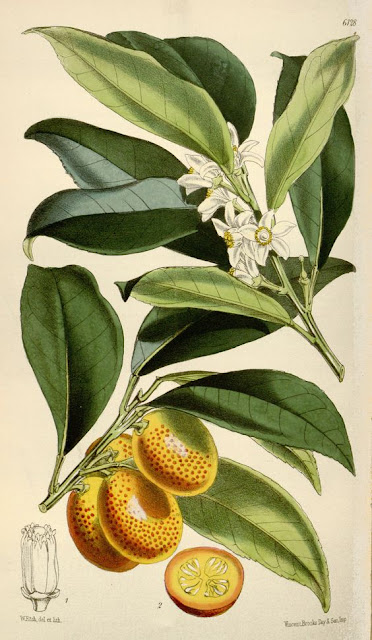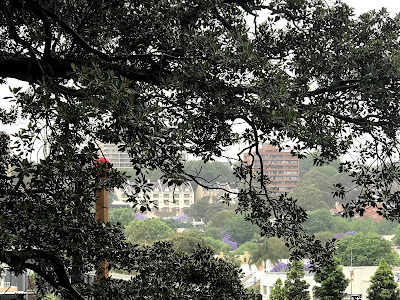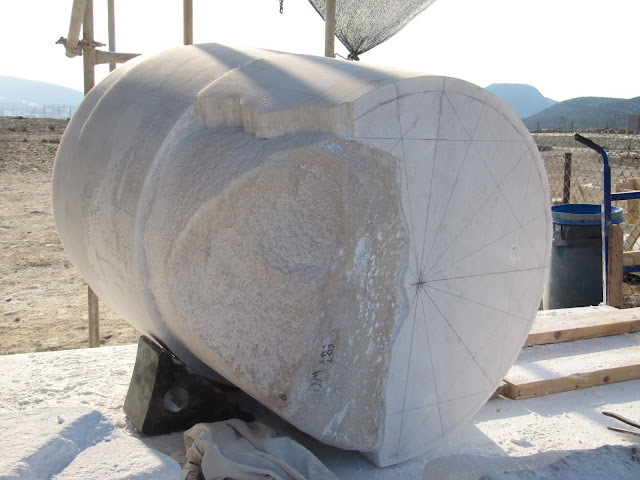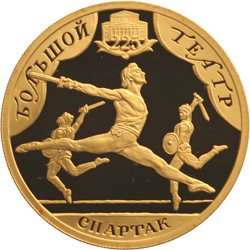I wish you a Merry Christmas and a Happy New Year, Dear Reader!
Monday 24 December 2018
Tuesday 18 December 2018
Noël! Noël! 2018
It's feeling a little bit German around here this Festive Season. No, not like the illustration above; it is, after all, a topsy-turvy world here in the Antipodes. It has been distinctly stormy and steamy this week (or sultry, as my Italian father-in-law was wont to say), as we run headlong toward the Summer Solstice. We've even had some Dramatic Wind to contend with around the Pipistrello roost and the emergency services came to salvage a neighbour's crushed car from under half a decades-old Ficus rubiginosa that had split down its middle in our driveway, but I digress...
I had thought to put paid to the ghastly, commercial, boxed Italian Panettone by baking my own this year (I do have plenty of candied citrus peel to get through) but have been distracted by a recipe for Stollen with a great hunk of marzipan through the middle (and thank you, Clever L for pointing out that they are to be found aplenty at Aldi, but That's Not The Point). It's not something I've ever eaten but it sounds delicious and the picture looks amazing. There are no longer 3 weeks left to have it Mature if I make it today but who's to know the difference? There are no connoisseurs of German baking around here. Not that that stops me from mucking around with new things. I can say now that after a few variations, Lebkuchen is not on my Greatest Hits list and won't be revisited again but Bethmännchen is a keeper and Pfeffernüsse is on my list for today. Yes, I shall be whipping up my own marzipan and Lebkuchengewürz before dazzling myself with some new hausfrau skills. I am optimistic! I'm loving my new German vocabulary, too.
 |
| This'll be Pipistrello later today |
These past years, we've musically launched ourselves into Christmas by taking in some olde worlde carols with a group of friends at the concert which rounds out the Australian Brandenburg Orchestra and Choir's season. We regrettably missed 2017, so Mr. P and I were determined not to miss the Noël! Noël! Baroque-fest this year. Off we trundled, our little group of carol faithfuls this year limited to just us and J&P, to the acoustically atmospheric St. Francis of Assisi church in Paddington, our expectations high. And we were not disappointed!
 |
| Not Paul Dyer! |
 |
| Hildegard working hard |
 |
| Johann Crüger's Lutheran chorale |
We heard a range of pieces, from Gregorian chant to Irish lullaby, instrumental arrangements of crowd-pleasing carols like We three kings of Orient are, and vocal arrangements of the likes of White Christmas. A stunning piece by contemporary choral composer Ēriks Ešenvalds, Only in sleep, with its shimmering cymbals was as traditional and carol-y as Johannes Eccard's early Baroque polyphonic work, Ich steh an deiner Krippen hier.
 |
| Like the Brandenburg, dressed by the C16th M.J. Bale |
George Frideric Handel's colourful Baroque aria, 'Let the bright seraphim' from Samson, was a terrific showcase for Bonnie's voice (now cutting an elegant figure in a white Grecian-esque gown) and the Baroque trumpet talents of Leanne Sullivan. Like the magic of agrodolce, what sounds on paper to be a very unhappy pairing makes for an exquisite surprise!
 |
| Not Leanne Sullivan! |
Saturday 1 December 2018
Citrus Redux
 |
| Citrus Bounty, circa 1620 Jacob van Hulsdonck |
No complaints from me, however (and not just because the mangoes and melons and stone fruit of summer are filling the void and Look!, cherries!), because during those times of plenty, Pipistrello went all out for Preserving for a change.
Alongside the lemony delicious things like syrup and frozen useful bits I shared earlier about these pages, I did add some candied lemon peel to the list, which is very nice with coffee. And a gift of limes were similarly treated, but I forgot to pare the rinds for candying, so that'll be for another time.
 |
| Fortunately, we love the Fortunella margarita |
For a twist on brandied kumquats, I made a batch with a bottle of Brazilian Cachaça, as it was what I had to hand. The resulting fruits are not quite as I expected, they're chewier and of a fire-breathing nature (and a different recipe will be employed next time), but we think that they will work skewered on a cocktail stick in a martini, so we could have a carefree Mad Men Party any old day now. The decanted sugar and Cachaça, too, is a rather interesting spirit now and when we are gripped by needing a caipirinha at said party, we are set, otherwise it's a potent drink to sip neat.
 |
| Breakfast at our place these days |
Off to the Greengrocery, I trundled, in search of some oranges and lo! Citrus x aurantium* (a.k.a. Seville oranges) aplenty were to be had! Armed then with these preciously rare, bitter oranges, I consulted Arabella Boxer's recipe, which boils up the fruit whole, and is thus a doddle to make. Twenty jars later, I made a Blue Ribbon-worthy first attempt at Seville Orange & Grapefruit Marmalade and Seville Orange & Ginger Marmalade (plus four jars of Framboise-scented Strawberry Jam, as I was on a roll!). While 24 jars of breakfast preserve seems like a lot for two people to get through, and it is!, it has been rapidly whittled down as they do make handy gifts and I was keen to get a broader Taste Test.
Verdict: I have a new feather to add to my cap: Marmaladière to Friends & Family!
* Back in the Olden Days when the Pipistrello's had a garden of their own, I did valiantly try growing Citrus × aurantium var. myrtifolia, a.k.a. the Chinotto orange, as I fancied trying my hand at making Chinotto. It all came to nought as the tree never flourished. Notwithstanding these failed experiments, next up on the list is an attempt to make my own Tonic Water, as G&T season is almost upon us. A few more citrus bits will be employed for that recipe, too.
Thursday 22 November 2018
Spartacus!
Spartacus! A household name, courtesy of Kirk Douglas, and a masculine, earthy 1950s Russian ballet for the balletomanes among us. Aram Khachaturian's story of the Thracian gladiator's slave revolt of 73 BCE has had a vivid reworking for the Australian Ballet's 2018 Season by choreographer Lucas Jervies and renowned costume and set designer Jérôme Kaplan, and Mr. P. and I had a chance to see for ourselves at the Sydney Opera House. Another ballet not previously seen by this Correspondent but I am pleased to report it was a very entertaining night out for all, and for we, of a particular vintage, surprisingly nostalgic.
When the curtain rises on Crassus' triumphal march into Rome, parading the Thracian captives, including Spartacus and his wife Flavia, I was transported straight back to the age of 11. The flag-bearers in their white mini togas and what looked like white bobby socks and plimsolls dancing around the stage in formation, put me immediately in mind of my participation in the Opening Ceremony of the 1977 Pacific Conference Games in our nation's capital. I was one of 1600 ten and eleven-year olds who ran about the stadium in our matching white outfits and waving a coloured ribbon in a choreographed ballet of our own, to the surging tune of "Fanfare to the Common Man", followed by the very convict-reminiscent folk ditties, "Bound for Botany Bay" and "Waltzing Matilda"*. Rousing stuff!
But, lo, the 1970s nostalgia didn't end there! Khachaturian's lovely score, beautifully performed as ever by the Opera Australia Orchestra, includes the Adagio of Spartacus and Phrygia (a.k.a. Flavia), instantly recognisable as the theme music to the long-running BBC drama, The Onedin Line.** While I cannot for the life of me remember anything of this popular maritime series, my guess being that the show probably coincided with bedtime, the music was a bolt from the past. It may need adding to the growing list of televisual viewing, as we do love a good Costume Drama around these parts.
Speaking of telly, the hat trick of reminiscences came in the form of Jérôme Kaplan's sleek and spare sets and costumes. While the gladiators were mostly clad in skimpy nothings and were even beefed up a little beyond the usual danseur's physique, (to the great delight of the Older Ladies sitting beside us; there was even a little bit of "Phwoar"-ing as they took in the programme before the curtain rose and a veritable frisson rushed around the dress circle at times), the Patricians wore precisely the sort of outfits that were the staple costume of all the Sci-Fi programmes from the glory days of the Space Race. M. Kaplan's formative years were evidently spent watching the same shows as the Pipistrello's.
 |
| Photo Credit: Jeff Busby |
 |
| Photo Credit: Jeff Busby |
Our principal dancers for the night were Jarryd Madden as Spartacus, Robyn Hendricks as Flavia, Andrew Killian as Crassus and Valerie Tereshchenko as Tertulla. Well danced, all!
Bonus Treat: For any dear Reader so inclined, I'm attaching the link to the Australian Ballet's very good website, where they have a short video on the costume design, here, and a tantalising snippet of the costumes in action, here.
* Australia didn't abandon "God Save the Queen" as our national anthem until 1984, prior to which Pipistrello fondly remembers school assemblies cycling through all the candidates for years, enjoying singing characterful folk ditties about our convict forebears before being saddled with the turgid "Advance Australia Fair".
** I was surprised to read on Wikipedia that The Onedin Line contributed to the fall of the Romanian dictator, Nicolae Ceauçescu.
Monday 12 November 2018
The Colour of Sydney
 |
| Jacaranda Time! |
But for the rest of us, tourists and locals alike, they are much beloved and when they put on their splendid display, it's worthy of celebration. The Pipistrello's are particularly lucky to live in an older part of the city, where the trees are abundant and well-established, and as we aren't tasked with the job of cleaning up after them, we are quite happy to Make a Fuss over their seasonal glory. Even a grey and wet day is made brighter by their pop of colour peaking out over rooftops and across vistas.
 |
| The Harbour Bridge glimpsed across rooftops |
 |
| The spring streetscape on a sunnier day |
The exhibition John Russell: Australia's French impressionist** was the first survey of this artist who spent forty years from the 1880s in Europe, studying first at the Slade School of Fine Art in London, then under Fernand Cormon in Paris. There he settled into the avant-garde set and experimented with emerging styles and the exhibition is thusly broad and ranges wide. Along the way he formed close friendships with Van Gogh and Rodin and had an influential encounter with Monet in Brittany, which is evident in some of the works which I did prefer (unsurprising, as my taste, as mentioned before, is so very Pedestrian). Alongside Russell's work there were pieces from his friends and contemporaries and a series of Rodin's busts of his wife, Marianna.
Behold, some of my favourite paintings of John Russell's, a former resident of our 'hood come good:
 |
| The garden, Longpré-les-Corps-Saints, 1887 |
 |
| Antibes View from Hotel Jouve, 1892 |
 |
| Rough Sea, Morestil, Belle-Île, c1900 |
 |
| Stormy weather at Belle-Île, 1904 |
 |
| Beneath the canopy |
 |
| Painterly palette in Cathedral Street |
 |
| Classic old pub on Cathedral Street |
 |
| Mrs Russell among the flowers in the garden of Goulphar, Belle-Île, 1907 |
 |
| Pear blossom in grey, 1920 |
 |
| Rainswept view from the AGNSW across to Woolloomooloo |
* In the unlikely event a Youth is lurking about these pages, Get Back to your Studies!
** If this exhibition is News To You, sadly, you have now missed it.
Thursday 25 October 2018
Chemistry At Home & A Fruitless Experiment
I'm rather fond of playing with a bit of Chemistry in the home. Nothing too technical, nor beyond me requiring more than my kitchen scales and some litmus paper; just the sort of stuff that housewives used to knock up without much fuss in the days before the White Lab Coat of Authority sternly told us through advertising that only factory-produced household sundries &c. are to be Trusted, and anyways are so much more Convenient, and thus those little skills nearly vanished overnight.
 |
| Handy Household Reference |
 |
| Pipistrello's Frugal Tip: Make your own mucilage, instead! |
Truth be told, some of the ingredients for the myriad recipes are a tad hard to come by these days, if not downright illegal, and serve to remind the Modern Reader just how far Society has regressed in its trust of our Fellow Man. I'm sure some sideways glances would be cast at my local Chemist if I was found to be shopping for some Sodium Cyanide (NaCN) and Mercury (Hg) and what-not for my Iron Rustproofing Solution. But if the End-Of-Days comes and Electricity & Google were to be switched firmly Off then the Pipistrello's will be fine as I now have my handy recipes for making the Rubber Bands which will be necessary for holding our post-Apocalyptic world together and the Tutti Frutti Essence which will add a bit of colour and flavour to our fallout-grey lives.
 |
| Rubber bands, so essential for navigating the Post-Apocalyptic Future |
Anyhow, it has been a Bit of a Year here, what with one thing and another, and the Pipistrello colony has had to become rather more intimately acquainted with some new-fangled advances in the Field of Medicine than we none of us had expected a little while back. One of the many joys of belonging to a family means that while one member may get the Hands-On Experience, we all get to Learn Something. Today's Lesson, concerning the treatment for a Gentlemen's Complaint, comes not from my copy of Two Thousand Formulas &c., nor even from Modern Western Medicine but from something more thrilling and far, far older: viz. Traditional Chinese Medicine ... Or would have, if Australia's quarantine laws were not so stern and unadventurous.
Last weekend, over at my Brother's place, the Gorgeous A, whose culinary talents are a rival to the transfixing Li Ziqi, was hoping to prepare a decoction for her father as an adjunct to the Western Medicine treatment for his, ahem, condition*. It may surprise you, or not, to discover that when she trundled down to the Chinese Herbalist to fill the "prescription", as dictated over the telephone by the Chinese Doctor in Guangzhou, he merely threw his hands into the air with frustration and declared that this infuriating country prohibits the importation of most of her required ingredients!
While we were all poised to discover how efficacious this Tonic would be, Gorgeous A's quest for seven Periplaneta americana** thus Came to Nought, and I have sadly no scientifically-tested results to report. Now if you know Sydney, you might puzzle over this Quarantine Mystery, as the humble American Cockroach and their German cousins positively flourish in this fine city (and are the pesky reason why my experiments with Home Curing have to be refrigerator-focussed) and wonder why the apothecary did not figure for himself, Oh, a gap in the market! Opportunity knocks!, for they abound in a free-range capacity here, and are thus ripe for canny exploitation.
| Coy and mysterious |
While we were all poised to discover how efficacious this Tonic would be, Gorgeous A's quest for seven Periplaneta americana** thus Came to Nought, and I have sadly no scientifically-tested results to report. Now if you know Sydney, you might puzzle over this Quarantine Mystery, as the humble American Cockroach and their German cousins positively flourish in this fine city (and are the pesky reason why my experiments with Home Curing have to be refrigerator-focussed) and wonder why the apothecary did not figure for himself, Oh, a gap in the market! Opportunity knocks!, for they abound in a free-range capacity here, and are thus ripe for canny exploitation.
* He is unlikely to be lurking about these pages so the shared confidence shouldn't cause further embarrassment.
** Yes, the American Cockroach is Farmed in China for the lotions & potions so-beloved by the Chinese. And while you may look askance at the prospect of being prescribed 7 in a tea, Your Correspondent caught and ate one, sashimi-style, as a toddler to no ill effect!
** Yes, the American Cockroach is Farmed in China for the lotions & potions so-beloved by the Chinese. And while you may look askance at the prospect of being prescribed 7 in a tea, Your Correspondent caught and ate one, sashimi-style, as a toddler to no ill effect!
Saturday 13 October 2018
Greek Series: The Marble Masons of Despotiko
 |
| Twilit Scaffolding & Cranework Adorning the Parthenon |
To see what it might look like when the Occupants have Moved In you must travel to Nashville in America, and behold the full-scale polychromic replica replete with a 42-foot tall statue of Athena (whose face is reputed to be modelled on a youthful Elvis Presley, according to the amusing docent who was my guide) - but I digress ...
 |
| Acropolis Restoration Work: A Giant 3D Puzzle! |
Yes, on Despotiko! You may be forgiven for thinking that Ol' Holiday in Greece of mine was a dim memory by now, but no! there's plenty more juice to be squeezed from that lemon! Here's another peek into the World of Archæology as seen by this Correspondent, before I forget any more of the Salient Details. Let me introduce you to some of these fabled Marble Masons in their natural habitat:
 |
| Just add Heat & Noise! |
 |
| What came before (well, an artist's impression) |
 |
| Not just a lump of rock: Restoration awaits! |
 |
| Gleaming new marble pieces ready for marrying up with the old |
 |
| A new-meets-old column base ready for shaping |
 |
| A Mason at one with his grinder |
 |
| Nearly ready for moving into place |
Nota bene: Allow a couple of hours for this stage - Rome/Athens/Egypt &c., weren't built in a day!
 |
| High-vis. optional |
 |
| Architrave ready to be winched atop two columns |
 |
| Architrave in situ and capped with more original bits (Not my pic! Photo Credit: Greek Ministry of Culture & Sports) |
If necessary, drill some holes for some titanium pins for later:
 |
| Ready for the next column piece |
 |
| In the rough, at this point |
Take plenty of time to stand back and admire your handiwork:
 |
| The old & the new |
 |
| All tidy after the 2018 Season |
 |
| Fun with leftovers on Paros, circa 1260 CE |
Subscribe to:
Posts (Atom)




